Our Wild Journey Travel diary
Main menu:
Namibia
 NAMIBIA
NAMIBIA
Sunday 7th June - Sunday 14th June 2009
...at 12.30 we left the border after maybe 10 min of paperwork - and started shooting through these 500kms of bushland in the Caprivi strip. There were not so many people, just nice bushlands, elephants and a few villages. The Strip has 3 parks - Mudumu national park, Caprivi game reserve and Mohango game reserve. We thought that the little amount of people was just the "calm before the storm", but there was nothing like that. Namibia has only 2 million inhabitants, so not as many humans as in other countries. Only baboons! :o) On the way through the strip we had to pass a few veterinary checkpoints, had to step on some desinfecting mats and they sprayed our car. They weren't really interested in ostrich and crocodile...they don't have "foot and mouth". Our camp we took around 100 km from the Okavango river, where we cooked a nice croc stir fry, and on the plate it looks much better than in the river! This we had again with Rene's favourite - sadza, some thick mealie meal broth. At night the temperatures weren't so comfy - only around 8 degrees! The next day we started early, passed the Okavango after 2 hours, shot through all the overpopulated areas (not many of them, but up here mainly...) and filled up on diesel before continuing our way towards Etosha. We left the San people (bushmen) there behind, we didn't want this commercialized attraction.
On an other veterinary checkpoint we stopped behind a white Landrover - belonging to a New Zealander-Swedish couple living in Switzerland - Milan and Louise. They came down to Namibia along the West coast. We chatted half an afternoon with them just behind the checkpoint - nice guys. We wished them nice experiences and happy travels and had to shoot off towards Etosha. On the way there we only stopped in Grootfontein to shop some bread and wine, we were happy, finally bread like in Europe and no more of this soft white, spongy stuff we had to eat for a long time now! Other products in Namibia's shops are like home - meat is cheap and a wide range of game meat available (oryx, springbok, kudu), fuel stations on every corner and a lot of car part shops - all in all more civilized than what we have seen since we have left home. From Grootfontein we took a backroad towards the Von Lindequist gate. As everything was fenced and no way for us to find a proper bushcamp we just camped next to an old farmgate a bit off the road, had a nice ostrich stir fry and slept in 10 degrees cold night, wondering how Etosha would be - 102 years of tradition, 114 species of mammals and 340 bird species...
Early in the morning we waited in front of the entrance gate for it to open and guess who came right behind us? Louise and Milan! Cool. Yesterday, 250 km ago we split and now we meet again in front of Etosha. Nice coincidence! They went around the 22.912 km2 a different way than we did. First thing we saw was a black backed jackal and some wildebeest - wishing us good morning! :o) A few kilometers down the track we crossed paths with a lioness - she just crossed the road in front of us, being very relaxed and not even looking at the car. Behind her came a male, shortly looking at the car and then also calmly crossing the road. They were on their way from the waterhole to their resting place for the day. Our camera clicked and clicked - we hadn't seen many lions on our trip yet! When they were gone we went on to our first waterhole - Goas, where we watched another 3 lions lazing around close to the water. Some brave impala went drinking anyway - probably some sort of "adrenaline sports". :o)
On the white, dusty tracks of Etosha we enjoyed its huge salt pan, the natural waterholes, endless plains of yellow grass, spotted by acacia trees and shrubs. We drove around all day and saw a lot of animals, springbok, zebras, elephants, gemsbok (oryx), impala and giraffes. At the end of the day we met Louise and Milan again, we decided to meet them up later on in their camp for a beer. They were on their way out, we still had one more waterhole to visit and as it is usual for us we didn't make it in time to leave the park (they close the gates at sunset) We drove the 70km back to the gate in half darkness, but all animals were wide awake. On the road we met a group of 8 bat-eared foxes, cute little foxes with huge ears. While we rushed back to the gate we saw approx. 40 giraffes (Andrea stopped counting), mainly on the road, 2 hyenas, 5 elephants and a few jackals. We had to convince the wardens to open the gate for us, apologized and rejoined Louise and Milan on the campground. The way there was through a private game reserve and we saw another lioness walking alongside the road, absolutely not impressed by our presence.
The gate to the camp had to be opened by us - Rene jumped out and opened it, when, just a few minutes later we heard the lions roar right behind it! Lucky Rene! In the camp Louise and Milan had a cozy fire going and in our fridge the wine got cold - we cooked -what?- croc meat in thousand variations and with a nice wine chatted with these 2 nice guys till midnight. We watched a jackal roaming around the camp, trying to scrounge some food off someone and always sat in wind direction - he loved our food! (Andrea's new favourite is a jackal, she finds them cute and finally found the "favourite animal" of this trip! :o) ) When going sleeping we left our washing up outside and found out the next morning that this little "bastard" had stolen our wooden spoon (probably using it like a lolly since we had stirred the meat with it). Ah well, we have another one!
On the last day in Etosha we were lucky to see 2 more lions lazing around and again a lot of different animals around Rietfontein and Salvadora waterholes. On one plain we stopped to watch 2 jackals laying in the grass. One just watched back, the other one came, looked at the car from all sides and lay down again on the other side of the track, winking at us. In the afternoon we took the Northern exit of the park, the way led us along the Eastern edge of the pan. Just outside the park we found a little acacia forest, where we camped for the night before moving on towards the Angolan border and Oshikoto the next morning.
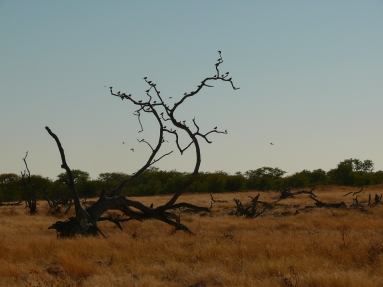
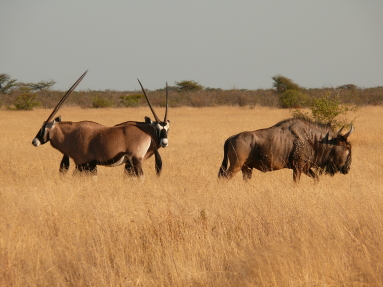
The tarmac road brought us through Odangwa and Oshakati till Ruacana, the landscape on the way not too spectacular as this is the most populated part of Namibia. (well, most populated isn't much either here in Namibia). The Ruacana Falls were disappointing and dead - just a little trickle down the rocks. So our decision was clear - we would HAVE to go to Epupa Falls 100kms of rough road further! The adventurous road took us about 7 hours and went alongside the Kunene river and up and down the Zebraberge-mountains. Sometimes Andrea got our of the car and cleaned some rocks to clear the way for the car. And even walking was faster than driving then! When we had a break under trees in a riverbend we got overtaken by 3 South African bikers - we had a short chat. In the afternoon we finally arrived - our bodies shaken from the horrible road and bumblebee happy to feel a straighter road. The falls were impressive, the Kunene river plunging down 60m into a gorge. The banks were lined by baobab trees and Makalani. We took a few photos and had a look around the local crafts market. There we met Victor, an Angolan orphan who was adopted by himbas. We agreed on him showing us something more about himba lifestyle - he would take us to a village the next day.
We camped not far from Epupa on a little hill among trees, sat by a nice campfire and enjoyed the silence. We went sleeping early because we were supposed to meet Victor early the next morning. He was there waiting for us, we bought a bag of mealie meal (maize flour) and together we drove 5km away into a little village, where Maria lives with her (!) German husband Uwe and 5 kids (one of them a "white Himba"). Maria didn't speak English so Victor told us a lot of interesting stuff about Himba life and culture. For example: Their houses are built from branches and clad with a clay-cowdung-mix, women always smear themselves with a mix of butter and clay and they really never wash (!). They just use a little sort of wooden pyramid, under which they light up some herbs and crouch over it to "smoke" the genitals. hmmmm....different! A man can have a few women and a woman can remarry after her husband's death - all in all a little less strict than in Maasai culture. Women nowadays use more vaseline or petroleum jelly for the clay, not so much butter and cow fat anymore, so we can't say that they have a strong stink about them - just the indigenous smell of milk, butter and smoke, just like the Maasai. And for some of their beadwork they also use beads made in Czech Republic - just like the Ethiopian tribes. In fact, the Himba have quite a lot of similarities with the Ethiopian Hamar tribes - culturewise. Just after lunchtime we said goodbye, brought Victor back to Epupa and moved on South. If ever anyone is looking for a good and knowledgable guide to one of the Himba villages, go to the crafts market at Epupa and ask for Victor - his price is a tenth of what you pay through the campsite! His phone number: Victor Nasisu, 081-3495757, a nice young man.
We drove a bit South and then wanted to fuel up and go on a 4x4 loop to Van Zyl's Pass and Marienfluss, but unfortunately there was no more diesel at the pump so we had to change plan and go the shorter loop. Shame, because this pass is one of the nicest and most adventurous in Namibia and there are said to be a lot of wild animals in the Marienfluss plain. Well, next time...
So, the 200km loop we took was about the same adventurous - the track started nicely, soon went from bad to worse, We went through mountainous country with about 3 villages on the whole way, sometimes we went along the Hoarusib river. Beautiful, amazing, spectacular! The road was either gravel, sand or big rocks. After a steep descent in "trial mode" ( 2 kph) and the sun setting Rene had enough and we camped in a dry riverbed - the same rocky ascent on the other side we left for the next morning. We didn't hear many animals at night and in general there isn't much wildlife in these rocky hills, there is more in Marienfluss. The next morning we had to clean up the road again as well to save the bottom of bumblebee, so morning exercise for Andrea. :o) This road was really fun to drive and gives one a real "wilderness feel". From Etanga the road was wider and grated and Rene took it a little too fast till Opuwo...arriving in town we noticed that one of our tyres was broken - the first one in Namibia. We had it fixed in Opuwo...
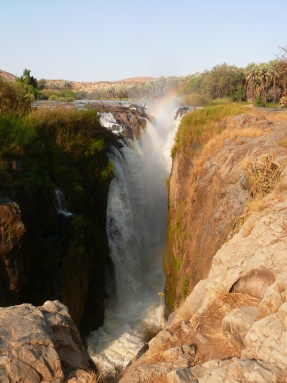
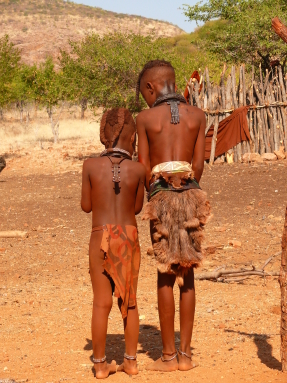
Monday 15th June - Sunday 21th June 2009
Through a little better road we came from the "high north" towards Sesfontein, where we just stopped for cigarettes and coke. We followed one Austrian's hint that there is a nice loop track starting in Sesfontein along dried out riverbeds. Apparently there were wild animals like antelopes, gazelles, lions, elephants and hyenas as well. Sounded like a mission for us! In the morning we followed fresh lion tracks and drove along a nearly dried out river - we took it too slow and got stuck in the mud, the car slowly sinking in! The nature on this loop is fascinating, everything is freely accessible, the nature, the wild animals and everything. We enjoyed it! This is like Africa from the books and movies! Digging us out from the mud wasn't that much work and we stopped following lions, went back to the main road and continued our way towards the Skeleton Coast Park.
The road is "main", but don't expect any asphalt - it's more gravel and some dips are really dangerous, one has to brake. The landscape is full of oryx and springbok and one can even find the occasional elephant. Just after the last "town" (3-4 houses) we had 2 more tyres punctured and had to find out that the tyre repair set from Czech Republic is really cheap Chinese rubbish! The material for fixing may be alright, but the tools already break when we took them from the package. :o( We somehow changed tyres and moved on to find a camp for the night - which we found on the road towards the national park. We heard zebras, howling jackals (something for Andrea) and had hyenas around the car at night, at least the tracks the next morning told us that.
We crossed the park gate just after opening (free permit required), already before the temperature dropped to 11 degrees, we had strong wind. The landscape changed, became more rough and rugged, only sand and rocks, even animals disappeared, we only saw a few jackals and ostrich. The Skeleton Coast is a really empty, inhospitable piece of land, there is just nothing, strong wind and no fresh water. The only animals roaming here are hyenas, wild dogs and jackals. Then only birds like gulls or shags. We could understand now that any survivors of a shipwreck here would face certain death!
Half of the coast is closed to visitors, in the North there are still 2 wrecks which are maybe worth seeing, but access there is only by plane. 2 more wrecks (Suiderkus from 1976 and Henrietta Spashetti from 1968) which are close to Torra and Terrace Bay. We didn't go there as one needs an extra permit to get there, but the weather permitted us to see the "South West Seal" from 1976 and the "Winston" from 1970. There was also a wreck signposted "Old Wreck" but we don't know the name of this one. Another one we saw is at Die Walle, it's just a year old wreck, a fish trawler (an illegally exported ship which was supposed to go to Nigeria...well, it didn't work out!)
The whole trip along this coast we had problems with our tyres, the damaged steel rim from Zambia didn't keep the air and every 50 km we had to stop and blow 2 tyres up. We stopped at a rusty, old oil rig to have breakfast and get out of the wind, when Rene found out that the compressor had stopped working. Yahooo - 2 flat tyres, no more spares and no cars passing by! So he took the compressor into pieces, checked it, somehow put it together and it worked again - the switch had been broken. We were lucky, in 4 hours we hadn't seen any car passing by - traffic up here is really minimal.
After this we could finally proceed, after a few kilometers we took a turn towards the "Winston" wreck, Through our binoculars we noticed 2 people, apparently taking a walk on the beach. After we drove 3 k's off the mainroad and to the beach we noticed that these people weren't walking, but looking for help. We had seen why - their rental car, a 2x4 was stuck in deep sand just by the beach. We drove back to pick them up (we had to stop before and blow up our tyres) and so met Laura and Juan, 2 Spanish tourists on a tour through Namibia. They were lucky we came, in their 2 week holiday they already lost 3 hours of waiting, we ourselves would had nearly needed help and just NO ONE passed, it would have been a cold night out there! To pull their car on a strap out of the sand was impossible, they were too deep and we would have got stuck as well, so we used our -some call it useless- winch for the second time (remember, Ethiopia?) to pull them onto steadier ground. We had once used it to pull ourselves out, now it was to help someone else, and on the coast the weather was really hostile! After a while we got them out and their car was on hard sand. phew! We had to pump up our tyres again, had a cigarette with them for the nerves and agreed on meeting each other in Longbeach close to Walvis Bay the next day. Happily, they drove off and we continued visiting wrecks, but soon the weather got colder, we had very strong front wind and Bumblebee used a lot of diesel fighting against it.
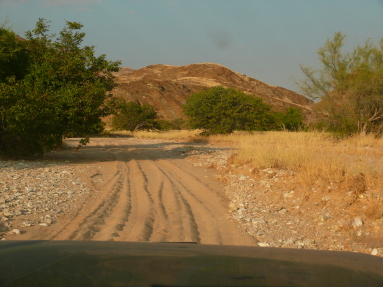
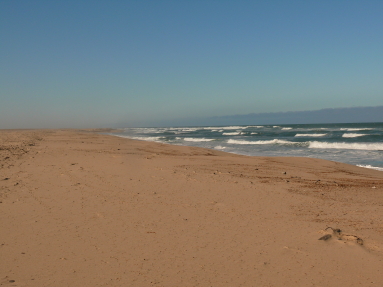
...because of this experience we only made it to Henties Bay, where we found a supermarket, a petrol station and a tyre repair shop - but all closed because it was dark. We just went behind the petrol station and slept there. In the morning, there was a slight drizzle, we couldn't start because we had emptied both our batteries - so Rene flagged down someone to give us a jump start. After that we pumped up the tyres again and moved on to the tyre service across the road to have these fixed. And - we didn't believe our eyes - we found a self service laundry (months of handwashing came to an end!) where we left our clothes to wash and drove back to Cape Cross to have a look at the seal colony, one of the biggest ones in Namibia with more than 100.000 Cape Fur Seals! As everywhere along the coast here,, the area is a little depressive, just grey rocks and sand, the hammering waves of the Atlantic ocean crashing on the beach. The stink of the colony was tremendous, it came from dead young seals, among the seals were hyenas and jackals walking, trying to steal weak young seal-pups. All in all a short visit is enough, we took quite a lot of photos (also of a sick, skinny wild dog), but the horrible weather drove us back into the car. We came back to Henties Bay, collected our washing and continued to Die Walle, last year's wreck along the coast.
In the afternoon we finally made it to Steffen, who was a German living in Swakop. He got recommended to us by Thomas, meanwhile an ex-friend of Rene. We arrived there, unloaded the car (it would be parked on the street) had a welcome beer and then left because we had our meeting with Laura and Juan. We chose a little restaurant by the sea, had nice dinner there, drank a lot of Namibian beer and talked a lot. Around midnight we went back to Swakop, after a nice evening with these 2 guys. They are the same crazy about Africa as everyone who comes one time and then always has to come back! :o)
The car needed some more tyre repair and other stuff, we spent 2 days properly cleaning it, vacuum-cleaning the dust and make it look like a car again. In the evening we had a braai with Steffen and his wife with South African wine. Rene and Steffen drank till 4 in the morning, Andrea went to bed at 1. The next day was a hard one for Rene - Andrea kicked him out at 7 in the morning, because he had to drive the car to the workshop to get fixed. Like a zombie he got up. The car needed some welding, one chassis-body-bolt connection was ripped out. We had to come and pick the car up in the afternoon, so we had the whole day for a relaxing sleep, which we really needed, not only because of the previous night.
On Saturday we had a look around Swakop, found a nice shop for biltong, dried meat of Oryx, Kudu and Springbok. We also bought some veggies and oil for the car. In the afternoon we went back to do more cleaning on the car. In the meantime, Louise and Milan had come back from Namib-Naukluft with their friend Nick, they planned to go on a quad tour through the dunes and asked us to join them. At first, we declined because of money, but as the atmosphere in Steffen's house was more or less poisened and boring, we decided to go. These 2 hours quad-riding on the dunes between Swakop and Walvis Bay were really nice, and of course we finished this nice day in a pub with a good burger and beer!
About our visit to Steffen's house we don't wanna talk so much, we had to soon learn that the "invitation as guests, not as customers" meant they wanted money anyway, although they declined our offer and played friendly, which later on came back to us as ridiculing us...anyway, a sad story about sad people.
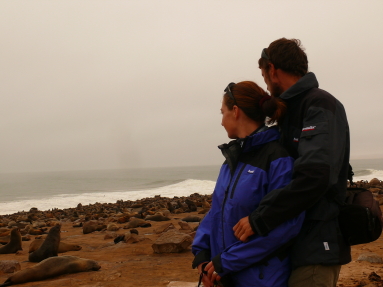

Monday 22nd June - Sunday 28th June 2009
...after leaving Steffen's place we still stayed around Swakop for a few days, bushcamping and trying our luck fishing in the ocean. A lot of luck we didn't have, mainly we collected yummy black mussels from the rocks between Swakop and Walvis. In Swakop we found a butchery which offered Springbok steaks for a fantastic price - 3 USD a kilo! Of course we took! Then we went buying some veggies for Andrea, came back to the parking, and look who we saw? A known Czech couple who had parked their car provocating right next to ours, but then decided to alight from the car both through the passenger's side to avoid us...maybe our clothes smelled too fishy from angling? Or they didn't like us telling the truth about "info-sucking" people who don't give nothing back! :o) And after a drive to Dune No. 7 and the back road behind the impressive dunes we left on the C 28 towards Windhoek. The road was winding through mountains and plains, where we saw a lot of antelope and other animals. The first night we slept in a dry riverbed in the Northern part of the Namib Naukluft Park, The next morning, when we just wanted to cross the park border, a young springbok was afraid of our car and in front of our eyes tried to run through the fence - with a big crash it landed on the other side. We were stupefied and ran there to untangle the springbok from the fence. It had scratches and a little blood. At first we thought everything is ok, but when we tried to lift it up on its legs it just crashed down again - it had broken its spine and couldn't move its hind legs. :o( Sad story, we decided to call the ranger. He came shortly after, but unfortunately the springbok would have to be shot. He said he would feed it to the vultures and jackals - what a terrifying end for this little creature!
After this we continued our way, the landscape after the park changed into a mountainous area, got a bit rockier and about 100km from Windhoek we came up to 1900m, crossing the Bosua-Pass. We had a good overview from there. Our camp spot we found approx. 30km outside Windhoek in the bush with an amazing view over Namibia's capital. On saturday we went shopping a few things in Windhoek, having a look around the town centre and checking the internet. But we were happy to leave town again and come back to our beautiful campspot, where we stayed till Monday, Rene working on the car, Andrea on the PC. In the evening we grilled nice springbok steaks with potatoes - very tender meat! People visiting Namibia should definitely try some game meat! Before going to bed we had "good night wishes" from a group of jackals howling for us!
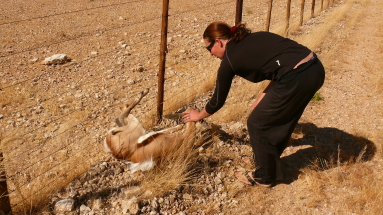
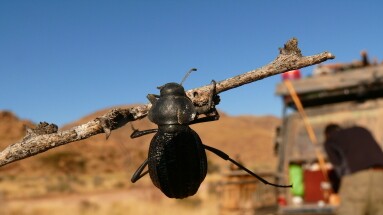
Monday 29th June - Sunday 5th June 2009
...after the weekend we finally got our permits for the shopping we did, then we could leave town and continue towards Namib-Naukluft National Park to see the famous orange sand dunes. From Windhoek this is about 350 km away, and no tarmac but only gravel. From the hilly Rehoboth the road winds through -typically Namibia- unused and wild farmland till the dunes and the park starts. We had amazing landscapes of brown, orange or black hilltops with yellow grassplains between them, all in all a very majestic panorama accompanying us along the road. The usual herds of springbok, oryx and ostrich on wide fields, even cows we saw again. They didn't feel disturbed by the cars and just continued chewing on yummy grass. Just before entering the park we stopped for a little bushwalk along the 23 mio year-old petrified dunes - a very interesting and beautiful sandstone formation. Between these dunes and the park our Bumblebee turned the 200.000 on the clock - birthday! :o) Congratulations!
Namib Naukluft is about 50 sqkm big, all of it covered in gravel plains, rugged mountains and a sea of orange sand - dunes up to 380m high towering over these gravel and grass plains. Mostly divided by dry river beds and salt pans(at the time of our visit), this park got most of its names from the Nama-dialect about 101 years ago. We paid and on asphalt road cutting through salt pans and dunes we drove the 64 km till Sossusvlei, where everything is about this one 325m high sanddune. Climbing that one is a piece of work, but once you are up there and forget about the other masses of tourists there it's amazing to lok out over the landscape. We sat down, enjoyed the view, took a few photos and as last ones we came down. It was just before sunset and already some animals got active - mainly jackals starting to run around. We camped inside Sossusvlei close to the 4x4 track among the dunes, made a big, warming campfire and enjoyed the silence and majesty of this place (only jackals howled and strange birds sang) - all other visitors had left and we were alone there. At night, the jackals came to check if we hadn't forgotten anything edible outside. It's a shame that the park camps are so expensive (70 USD for 2 people!!!), we heard that jackals came there to sit around the fire with people, waiting for food (something for Andrea!).
The next day we left the dunes around lunchtime - after a magnificient sunrise- and still had a look on Sesriem Gorge, now quite empty and full of guano. :o) We left the park and on side roads drove towards Luderitz, through the Namib Rand private reserve. We wanted to have a look at the wild horses of Aus and see the typical German town of Luderitz. The horses we saw, counted around 40 of them, all coming to drink early in the morning. Hmmm...Luderitz itself looks like a forgotten town in a moonscape. Dry, rocky and sandy. We just had a look at Diaz Point and Grossebucht, but the town itself didn't take us. So on asphalt, we headed back to Aus. Till the sunset we drove and got closer to the South African border. Just after Keetmanshoop the next day we wanted to have a look at the "Quiver Tree Forest" and "Giant's playground", which was nothing enormous and breathtaking, but nice to see. The trees, Aloe Dichotoma, are strange to look at and grow mostly in dry, hot areas such as the Kalahari. They get up to 9m high and live up to 300 years. The name "quiver tree" derives from the San people using the bark of the tree to make quivers for their arrows. Between the rocks and flowers there we saw many birds, even some sort of kolibri, and hyrax, some sort of rock rat, which were laying in the sun on the rocks. After that we went to Giant's Playground, and it really looks like a giant played with marbles and building blocks and just left them there. One finsd them balancing and towering up. This was created by magma of an unerupted volcano, that just withered away in the millions of years of rain, sun and wind. After a relaxing walk between these trees and rocks we jumped into the car again and drove on just before Mata Mata, the border to South Africa. We noticed that we got closer to the Kalahari - the grass got shorter, bushes a little lower and the soil/sand more orange. Our last night in Namibia we spent in a dry riverbed, with a nice campfire, tranquillity and the far smell of a decomposing porcupine! (Rene buried it later to avoid the smell). The enxt morning we got up, saw the frost on the car and with cold hands drove into Mata Mata, a newly opened (from 2007) borderpost into the Transfrontier Kgalagadi. After a short "stamping out" process we left the 10th country of our trip and moved on to the next...
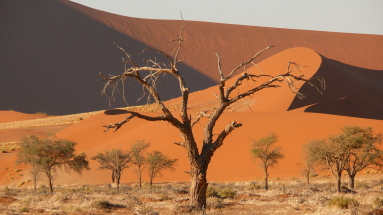
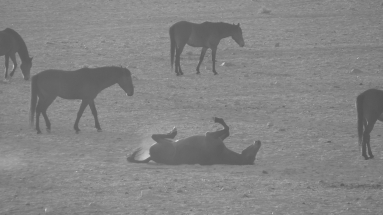
Namibia.
| Driven kilometres / Diesel total | 6.305 km / 856,6 litres |
| Days of travel | 29 days |
| Diesel price per litre | 6,90 ND = 0,90 USD |
| Accomodation | Bush camp possible |
| Exchange US Dollar / Namibian dollar |
1,- USD = 8,20 ND |
| Entry costs | 75,- USD (visa only Czech cit, road and carbon tax) |
| Break down + repair | 3 punctures, welding on body |